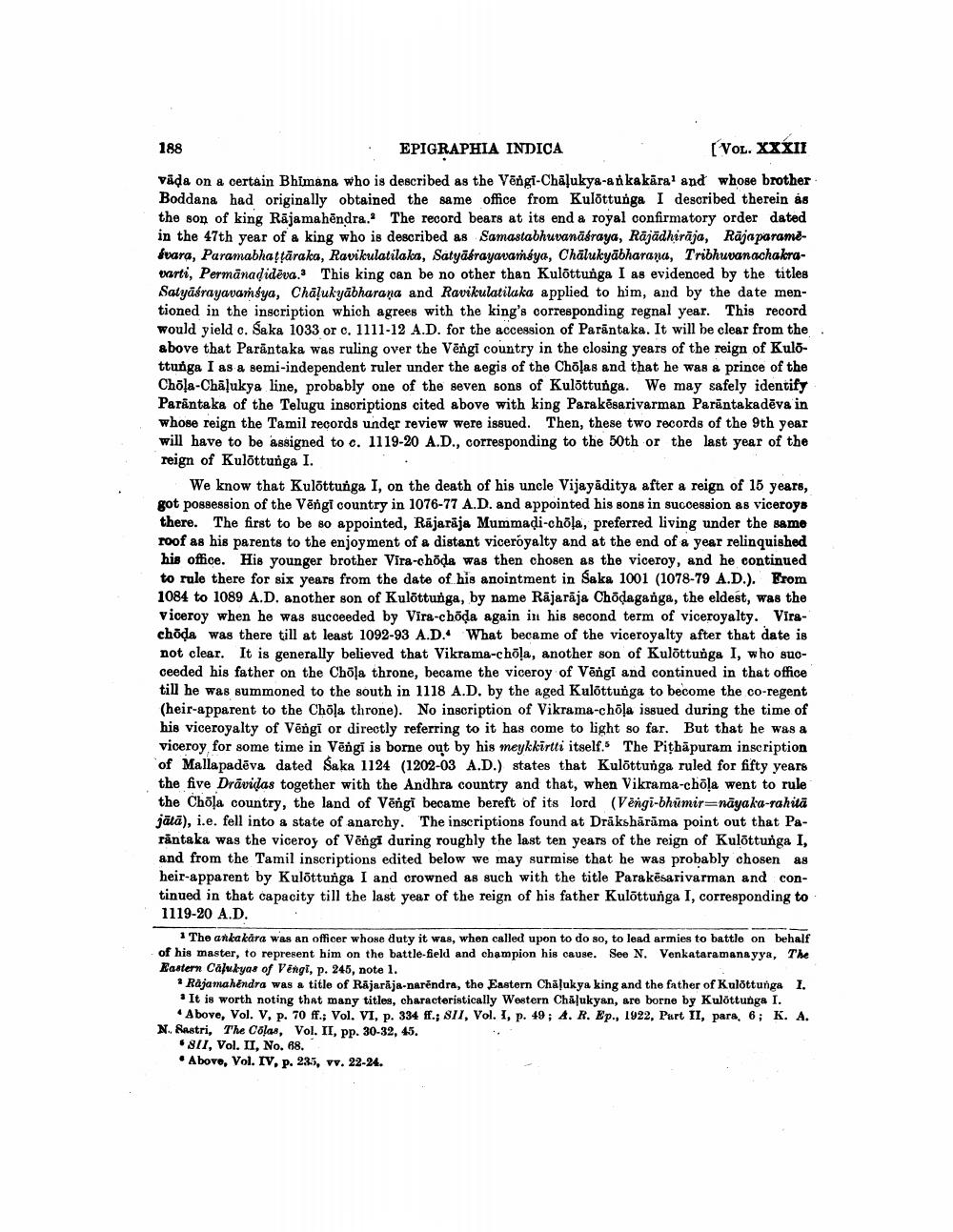________________
188 . EPIGRAPHIA INDICA
(Vol. XXXII Väda on a certain Bhimana who is described as the Vēngi-Chāļukya-an kakäral and whose brother Boddana had originally obtained the same office from Kulottunga I described therein ás the son of king Rājamahēndra. The record bears at its end a royal confirmatory order dated in the 47th year of a king who is described as Samastabhuvanäsraya, Rājādhiraja, Rāja paramefvara, Paramabhattāraka, Ravikulatilaka, Satyäsrayavaréya, Chālukyābharana, Tribhuvanachakravarti, Permānadideva. This king can be no other than Kulõttunga I as evidenced by the titles Satyāšrayavamsya, Chalukyābharana and Ravikulatilaka applied to him, and by the date mentioned in the inscription which agrees with the king's corresponding regnal year. This record would yield o. Saka 1033 or c. 1111-12 A.D. for the accession of Parāntaka. It will be clear from the above that Parāntaka was ruling over the Vēngi country in the closing years of the reign of Kulottunga I as a semi-independent ruler under the aegis of the Chōļas and that he was a prince of the Chõla-Chāļukya line, probably one of the seven sons of Kulottunga. We may safely identify Parântaka of the Telugu inscriptions cited above with king Parakēsarivarman Parāntakadēva in whose reign the Tamil records under review were issued. Then, these two records of the 9th year will have to be assigned to c. 1119-20 A.D., corresponding to the 50th or the last year of the reign of Kulottunga I.
We know that Kulottunga I, on the death of his uncle Vijayaditya after a reign of 15 years, got possession of the Vēngi country in 1076-77 A.D. and appointed his sons in succession as viceroys there. The first to be so appointed, Rājarāja Mummadi-chöļa, preferred living under the same roof as his parents to the enjoyment of a distant viceroyalty and at the end of a year relinquished his office. His younger brother Vira-chöda was then chosen as the viceroy, and he continued to rule there for six years from the date of his anointment in Saka 1001 (1078-79 A.D.). Brom 1084 to 1089 A.D. another son of Kulõttunga, by name Rājarāja Chodaganga, the eldest, was the Viceroy when he was succeeded by Vira-cbõda again in his second term of viceroyalty. Virachöda was there till at least 1092-93 A.D. What became of the viceroyalty after that date is not clear. It is generally believed that Vikrama-chõla, another son of Kulõttunga I, who suoceeded his father on the Chola throne, became the viceroy of Vēngi and continued in that office till he was summoned to the south in 1118 A.D. by the aged Kulottunga to become the co-regent (heir-apparent to the Chöļa throne). No inscription of Vikrama-chōļa issued during the time of his viceroyalty of Vēngi or directly referring to it has come to light so far. But that he was a viceroy for some time in Vēngi is borne out by his meykkirtti itself. The Pithapuram inscription of Mallapadēva dated Saka 1124 (1202-03 A.D.) states that Kulottunga ruled for fifty years the five Drāvidas together with the Andhra country and that, when Vikrama-chola went to rule the Chõļa country, the land of Vengi became bereft of its lord (Vēngi-bhumir=nāyaka-rahitā jātā), i.e. fell into a state of anarchy. The inscriptions found at Drākshārāma point out that Parantaka was the viceroy of Vēngi during roughly the last ten years of the reign of Kulottunga I, and from the Tamil inscriptions edited below we may surmise that he was probably chosen as heir-apparent by Kulõttunga I and crowned as such with the title Parakēsarivarman and continued in that capacity till the last year of the reign of his father Kulõttunga I, corresponding to 1119-20 A.D.
The anka kara was an officer whose duty it was, when called upon to do so, to lead armies to battle on behalf of his master, to represent him on the battle-field and champion his cause. See N. Venkataramanayya, The Eastern Calukyas of Vingi, p. 245, note 1.
Rajamahendra was a title of Rājarāja-narendra, the Eastern Chāļukya king and the father of Kulottunga I.
It is worth noting that many titles, characteristically Western Chāļukyan, are borne by Kulõttunga I. * Above, Vol. V, p. 70 ff.; Vol. VI, p. 334 ff.; S11, Vol. I, p. 49; A. R. Ep., 1922. Purt II, para, 6; K. A. N. Bastri, The Colas, Vol. II, pp. 30-32, 45.
.811, Vol. II, No. 68. • Above, Vol. IV, p. 23.5, vv. 22-24.




